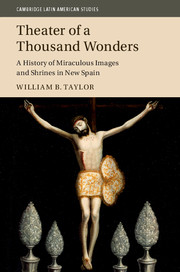Book contents
- Frontmatter
- Dedication
- Contents
- List of Figures
- List of Maps
- List of Tables
- Preface and Acknowledgments
- Archive Abbreviations
- Introduction
- Part I Bearings: Historical Patterns and Places of Image Shrines
- 1 Formative Developments, 1520s–1720s
- 2 Growth, Other Changes, and Continuities in the Late Colonial Period
- 3 Miraculous Images of Christ and the Virgin Mary
- 4 Advocations of the Virgin Mary in the Colonial Period
- Part II Soundings: Divine Presence, Place, and the Power of Things
- Conclusion
- Appendix 1 Colonial Image Shrines
- Appendix 2 When Shrines Began
- Appendix 3 Other Saints
- Index
2 - Growth, Other Changes, and Continuities in the Late Colonial Period
from Part I - Bearings: Historical Patterns and Places of Image Shrines
Published online by Cambridge University Press: 05 September 2016
- Frontmatter
- Dedication
- Contents
- List of Figures
- List of Maps
- List of Tables
- Preface and Acknowledgments
- Archive Abbreviations
- Introduction
- Part I Bearings: Historical Patterns and Places of Image Shrines
- 1 Formative Developments, 1520s–1720s
- 2 Growth, Other Changes, and Continuities in the Late Colonial Period
- 3 Miraculous Images of Christ and the Virgin Mary
- 4 Advocations of the Virgin Mary in the Colonial Period
- Part II Soundings: Divine Presence, Place, and the Power of Things
- Conclusion
- Appendix 1 Colonial Image Shrines
- Appendix 2 When Shrines Began
- Appendix 3 Other Saints
- Index
Summary
It would not be surprising to find that image shrines in New Spain declined during the eighteenth century, as they did in much of Catholic Europe, diminished by Enlightenment skepticism and individualism, government intervention to maximize tax revenue, minimize administrative costs, promote devotional sobriety and private soul searching, and a campaign to moderate costly and provocative public exuberance. In a way this would seem to have happened. Fewer new shrines and confraternities were established in the eighteenth century than during the long seventeenth century; some reputedly miraculous images and incipient shrines were suppressed; restrictions on alms collecting for local devotions of all kinds, including shrine images, were put forward by the 1790s; and priests who spoke of miracles increasingly felt obliged to assure authorities that they were not naïve seekers of supernatural signs. But decline, disenchantment, and rise of the spiritually “buffered self” pale in comparison to the many signs of vitality, official encouragement, mounting wealth, and popularity of image shrines, or the frequent news of miracles in the late colonial period.
The impact of Spain and Europe on the history of image shrines in America was felt directly but not uniformly during the eighteenth century, and not always in expected ways. Confessional crusades that pitted Protestants against Catholics had declined by 1700, replaced by the challenges of a growing conviction among educated classes that the universe was governed by natural laws more than by the omnipresent hand and will of God. But Spanish Bourbon administrators endorsed a paler version of the continental Enlightenment that did not question the existence of God as creator and mover of the universe or tolerate unfettered critical thinking. Their reforms were more instrumental, designed to apply secular, scientific procedures to policy and administration in order to strengthen the monarchy, spur material progress, maximize revenues, and burnish a mystique of absolutist order and royal benevolence without banishing the divine from human affairs. Catholicism remained the official religion of the Spanish kingdoms, although ecclesiastical authority was challenged in various ways. Royal administrators and regalist bishops were inclined to try to limit the priesthood to spiritual matters narrowly defined and to favor a less showy, more restrained public piety.
- Type
- Chapter
- Information
- Theater of a Thousand WondersA History of Miraculous Images and Shrines in New Spain, pp. 95 - 169Publisher: Cambridge University PressPrint publication year: 2016



